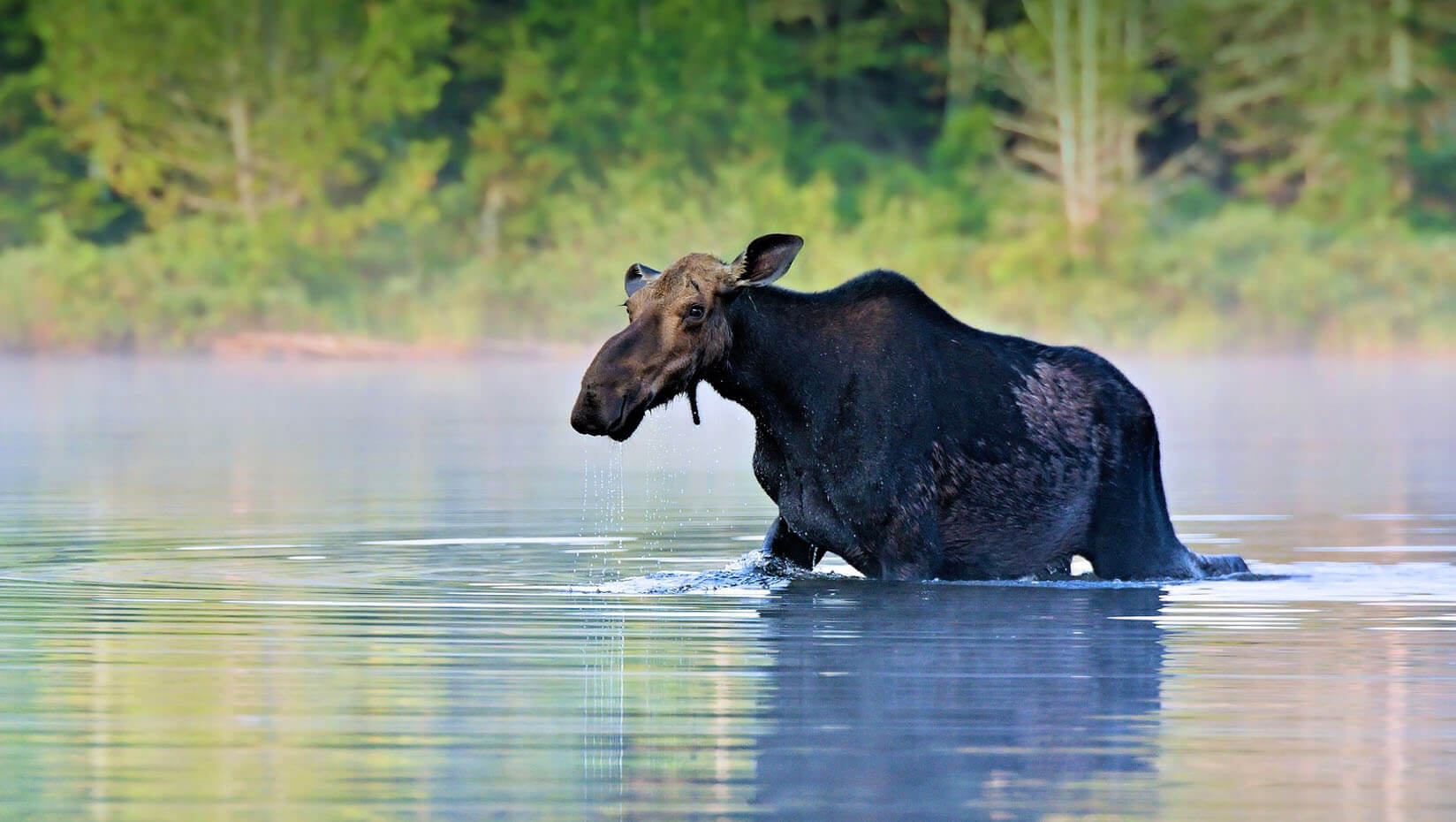
Kamath to examine impact of parasites on moose survival
Editor’s note: A Morris Animal Foundation news release is online.
Pauline Kamath will investigate how parasites affect moose survival and health to inform management strategies targeted at maintaining healthy populations of the large mammal in Maine and across North America.
The Morris Animal Foundation awarded the University of Maine assistant professor of animal health in the School of Food and Agriculture $148,492 for the three-year project that begins in January 2021.
Dramatic declines of some moose populations in North America over the past couple of decades are thought to be driven, in part, by increasing tick burdens that reduce winter survival, says Kamath.
Young calves are particularly at risk, which contributes to herd declines. Calves with heavy tick loads often die in their first winter and winter tick epizootics (during which more than 50% of calves die) have been increasing in frequency in Maine, she says.
There are an estimated 60,000–70,000 moose in Maine. While the population is believed to be stable in the state, Kamath says populations across the southern edge of their range in the United States are in decline due to winter ticks as well as other parasites.
Not a lot is known about how the increasing parasite burden impacts wildlife, says Kamath, who began working in the field of animal diseases while earning her doctorate at the University of California, Berkeley. She turned her attention to moose after arriving at UMaine in 2017.
Kamath is joined on the project by Sandra De Urioste-Stone, associate professor of nature-based tourism in the School of Forest Resources; Anne Lichtenwalner, Extension veterinarian and associate professor and director of the University of Maine Cooperative Extension Veterinary Diagnostic Laboratory; Sabrina Morano, assistant research professor in the Maine Department of Wildlife Fisheries and Conservation Biology; and Lee Kantar, moose biologist with the Department of Inland Fisheries and Wildlife.
The Maine Department of Inland Fisheries and Wildlife has been collaring moose for several years for its ongoing field study on the impact of winter ticks on moose survival and population dynamics.
Since 2017, UMaine has received blood and winter tick samples from collared moose and has been screening for intracellular blood parasites, including those from the genus Anaplasma and Babesia, which may be transmitted by ticks.
In Kamath’s project, the team will continue to screen for and evaluate the intensity of these parasite infections in moose.
“By combining infection data with information known on individual sex, age, location, condition, as well as nutritional, stress, and anemia status, one of our goals is to identify risk factors for parasite infections in moose,” she says.
The team also will conduct a moose genomic study to identify gene variants associated with tolerance to parasite infections. “Ultimately, we will use these findings to build a comprehensive survival model to assess and predict the long-term viability of the Maine moose population,” says Kamath.
In addition, De Urioste-Stone will examine stakeholder risk perceptions and prioritization of wildlife management actions for reducing the negative impact of parasites on moose health.
“This study will help us to better understand how stakeholders like recreationists and managers perceive the role of parasites on the health of moose, and inform management strategies that reduce negative impacts of parasites on moose,” she says.
The study is titled “Evaluating the Impacts of Winter Ticks and Tick-borne Disease on Moose Survival.”
This project comes out of initial work supported by the Interdisciplinary Undergraduates Research Collaborative (IURC) program at UMaine. Preliminary data generated from this internal grant was instrumental in making our proposal to the Morris Animal Foundation a success, says Kamath. In addition, several members of the research team participate in the One Health Initiative at UMaine.
This project will include graduate and undergraduate student training through UMaine’s One Health National Science Foundation Research Traineeship and Research Experiences for Undergraduates programs. The programs utilize transdisciplinary approaches — combining social and biophysical sciences — to better tackle challenging problems at the intersection of human, animal and environmental health.
Kamath has recruited a graduate student who will participate in the new One Health training program and conduct research that combines biophysical and social science aspects of the project.
In addition, De Urioste-Stone is advising master’s student Asha DiMatteo-LePape, who will conduct a survey this fall to understand recreationists’ perceptions of moose health, risks and opinions regarding management strategies. As an undergraduate in 2018–19, DiMatteo-LePape took part in one of the inaugural IURC research projects with Kamath, De Urioste-Stone and Lichtenwalner.
Kamath’s moose-parasite study is one of 12 supported this year by the Morris Animal Foundation’s awarding of $930,000 in wildlife health research grants.
The Foundation, which was started by a veterinarian in 1948, seeks to bridge science and resources to advance the health of animals. Studies focus on critical animal health challenges, including encephalomyocarditis virus in elephants, iron overload syndrome in rhinos, and health and reproductive consequences of noise on wildlife.
Read the Morris Animal Foundation release about its recent grants supporting wildlife research.
Beth Staples, beth.staples@maine.edu
